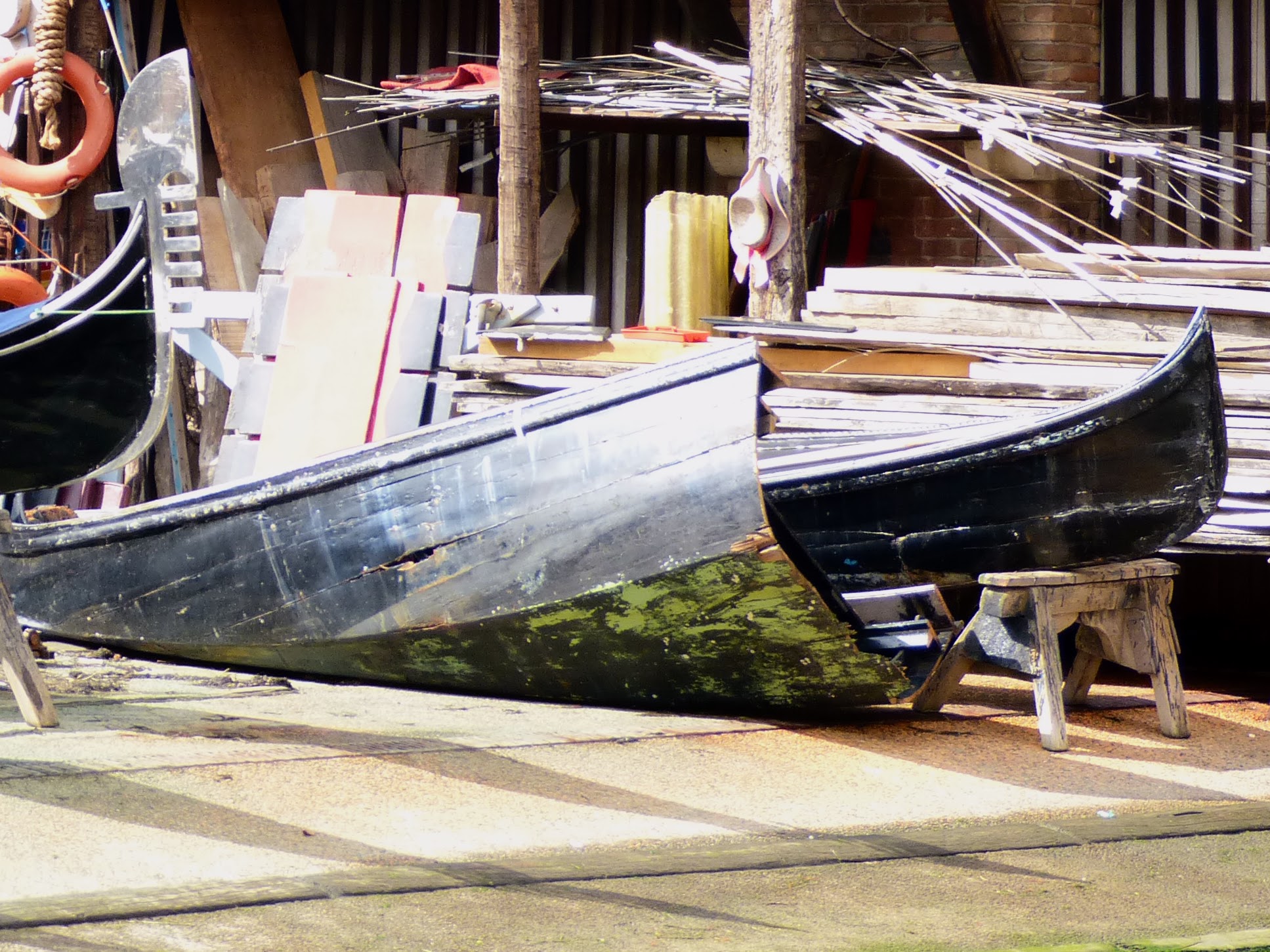Mention Venice and one of the first images that comes to my mind is a sleek, long, black laquered gondola gliding through the dark waters of the quiet canals, rowed gently by a gondolier in a striped shirt and straw hat. As we approach a blind corner he calls out a loud "Oeh!" and then pushes off the corner with his foot as the boat nearly misses scraping the water stained walls and crumbling masonry. Passing the wooden landing platforms with barbershop poles I imagine a time when the over 10,000 gondoliers were the only form of transportation along the 170 canals that intertwine the 118 islands that make up Venice.
But the quiet calm of the canal is more of a dream than reality. Today's trip down the canal has us backed up in a gondola traffic jam as we wait to get out onto the Grand Canal where we compete for space with the vaporetti that serve as the island's mass transit, the beautiful wooden motor boat taxis and a dozen other flatbottomed boats that serve as delivery, trash and even floating markets.
Even with all the traffic along the major canals a gondola ride is still a "must do" on any trip to Venice. Walk deeper into the more remote areas of the island to find your gondola and you will experience the Venice of quiet canals and old palaces. If you have a good imagination you might even step back into the time of Casanova when gondolas had small enclosed cabins or "felze" with louvers or slats (Venetian blinds) that ensured privacy and anonymity, and competing families built extravagantly decorated boats to show off their wealth. In 1562 however, sumptuary laws were passed to try to keep the ostentatious display of wealth throughout the city to a minimum and it was decreed that all gondolas be black.
Today the approximately 400+ flat bottomed gondolas are built entirely of wood; seven layers of black lacquer give it its glossy shine and the only metal on the boat is on the "risso" at the back of the boat and the "ferro" at the front which serves as a counter balance to the weight of the gondolier. The hood ornament or "risso" is filled with symbolism with the top curve said to resemble the doge's cap or the shape of the Grand Canal and the six prongs facing forward are said to represent the six sestieri (neighborhoods) of Venice with the rear facing prong represents the Giudecca. Some versions of the "ferro" include another three lacy forward facing prongs that represent the other three main islands of Venice: Burano, Murano and Torcello. The left side of the boat is about 10 inches longer than the right to balance out the tendency of the boat to turn to the left as the gondolier rows with the oar on the right. The beachwood oar sits on a "forcole" or oarlock which are still carved by hand, each is as individual as the rower. The forcole have eight different resting spots for oar and the eight different strokes the gondolier uses around the canals, allowing for shallow or deep strokes and fast or slow speeds.
Gondolas are still made by hand on the island of Venice on traditional workshops or "squeri" where the knowledge and plans are passed down through the generations. Two squeri are in central Venice with one, San Trovaso, close to the Accademia Museum and on a corner of a canal where you can watch the process from across the canal.
At a recent lunch I was thrilled to find over a dozen gondoliers having lunch at the same restaurant where we had reserved a table. My second glass of wine gave me the courage to make my way to their table to ask if I could join them at their table and take a picture to celebrate my birthday. Good natured and friendly they made room at their table and were happy to pose with me. After lunch as we were walking over a canal I heard a gondolier call up to me in a heavily accented voice "Heppy Beerthday! " It was one of my lunch-mates rowing by!
There are currently approximately 400 gondoliers in Venice. The rights to the coveted position used to be passed down from father to son and today the license is still hard to obtain. The gondolier must belong to the thousand year old Gondolier's Guild and train under an experience gondolier for 400 hours, pass rigorous exams that include nautical navigation, boat handling, culture, history and language skills. Gondola rides range in price from 80 to 100 Euros for a 40 minute ride. There are numerous places to start your ride, from the more crowded areas of San Marco, Accademia and Rialto to some more remote areas further away from the center. The further out you go the more you'll be able to chat with your gondolier to determine you have any chemistry. I've been disappointed by being being ushered into what amounted to a huge group tour of 20+ boats and then on another occasion being thrilled by a wonderful gondolier who took us through back canals where he gave us a history of the area and the only other sound we could hear was the swish of the oar through the water. If you have the time it's worth going out of your way to find a good match. For most tourists this is a wonderful opportunity to interact with a local and learn about the beauty and history of this beautiful city.



















